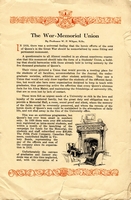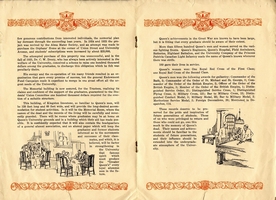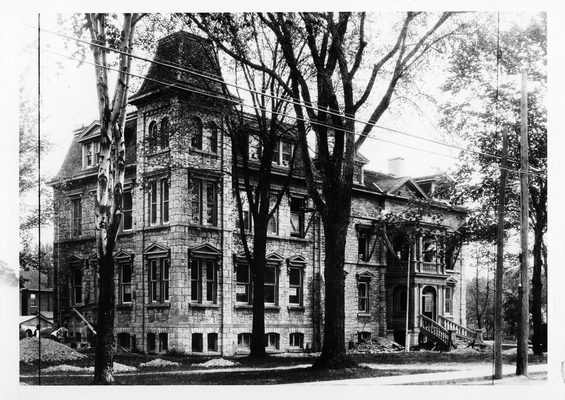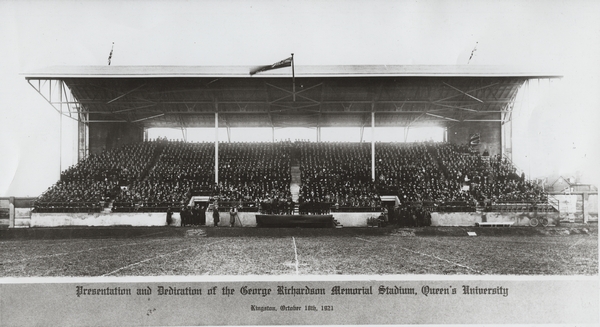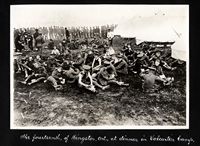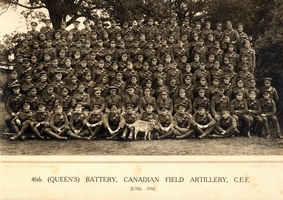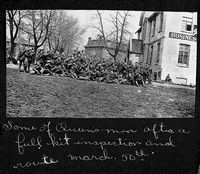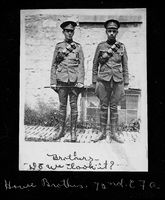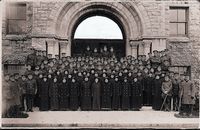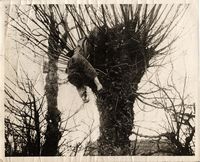Queen's Remembers: The First World War
- Campus Memorials
- Queen's Units
- WWI: Lives Lost (Story Map Part I, Part II)
Campus Memorials
The War-Memorial Union
By Professor W.P. Wilgar, B.Sc. [ca. 1926]
In 1919, there was a universal feeling that the heroic efforts of the sons of Queen’s in the Great War should be memorialized by some fitting and permanent monument.
A questionnaire to all Alumni resulted in an almost unanimous expression that this monument should take the form of a Students’ Union, a building that should harmonize with those already held in loving memory by the five thousand graduates of Queen’s.
Their vision pictured a Union that would provide a meeting place for the students of all faculties, accommodation for the Journal, the under-graduate societies, athletics and other student activities. They saw a Union that would not only draw together the students of the different faculties, but would also have some organization designed to keep in touch with graduates, thus preserving active the affection that every Queen’s alumnus feels for his Alma Mater, and maintaining the friendships of university life, that are so soon lost by lack of contact.
These were felt as urgent needs of a University so rich in the love and loyalty of its scattered family, but the great duty and obligation was to provide a Memorial Hall, a room, sound proof and silent, were the memory of the fallen would be reverently preserved, and where the records of heroic deeds of Queen’s men could be maintained in the atmosphere of daily life, and not shut away in the files of the University office.
This was an ambitious programme, but Queen’s has ever been small in numbers only. In 1920 there were over 400 returned men registered as intra-mural students, and within a month of the launching of the campaign for funds for the Memorial, the students and staff subscribed over $30,000. The Fifth Field Company, Canadian Engineers, contributed $4,000 in Victory Bonds, representing the pay of the officers and men of the company since its organization in 1910.
Unfortunately the canvas of graduates and former students was at this time neglected, and, with the exception of a few generous contributions from interested individuals, the memorial plan lay dormant through the succeeding lean years. In 1924 and 1925 the project was revived by the Alma Mater Society, and an attempt was made to purchase the Orphans’ Home at the corner of Union Street and University Avenue, and students’ subscriptions were increased by about $25,000.
The attempted purchase of this property was unsuccessful, and in the fall of 1925, Dr. C.W. Drury, who has always been actively interested in the welfare of the University, conceived a scheme to raise one hundred thousand dollars among the graduates, to discharge this obligation which he felt was peculiarly theirs.
His energy and the co-operation of his many friends resulted in an organization that gave every promise of success, but the general Endowment Fund Campaign made it expedient to merge in one great effort all the urgent needs of the University.
The Memorial building is now assured, for the Trustees, realizing its claims and confident of the support of the graduates, guaranteed to the Students’ Union Committee one hundred thousand dollars required for the erection of a suitable structure.
This building, of Kingston limestone, so familiar to Queen’s men, will be 120 feet long and 60 feet wide, and will provide the long-desired accommodation for student activities. In it will be the Memorial Room, where the names of the dead and the records of the living will be carefully and reverently guarded. There will be rooms where graduates may be at home on Queen’s University grounds and in a building which their aid has made possible. It is confidently expected that it will also contain the headquarters of a general alumni association, and an alumni paper which will keep the graduates and former students informed as to the movements and successes of their classmates, and which, it is believed, will be factor in strengthening in the University that famous spirit which much produce the “Greater Queen’s” every loyal alumnus sees in the future.
Queen’s achievements in the Great War are known to have been large, but it is fitting that every graduate should be aware of their extent.
More than fifteen hundred Queen’s men and women served on the various fighting fronts. Queen’s Engineers, Queen’s Hospital, Field Ambulance, Batteries, Highland Battalion, and the University Company of the Princess Patricia Canadian Light Infantry made the name of Queen’s known wherever there was strife.
189 gave their lives in service.
Queen’s women won: One Royal Red Cross of the First Class; one Royal Red Cross of the Second Class.
Queen’s men won the following awards for gallantry: Commander of the Bath, 2; Commander of the Order of St. Michael and St. George, 8; Commander of the Order of the British Empire, 2; Officer of the Order of the British Empire, 3; Member of the Order of the British Empire, 1; Distinguished Service Order, 21; Distinguished Service Cross, 1; Distinguished Flying Cross, 3; Military Cross, 121; Bar to Military Cross, 12; Distinguished Conduct Medal, 8; Military Medal, 22; Bar to Military Medal, 2; Meritorious Service Medal, 2; Foreign Decorations, 20; Mentioned in Despatches, 114.
These records deserve to be preserved for the pride and inspiration of future generations of students. Those of us who were privileged to return and those who could not go, owe this much to the memory of Queen’s dead. Their names and achievements should be familiar to the students of future generations, and their influence should be extended into the undergraduate atmosphere of the University.
George Richardson Stadium
"By the great kindness of Mr. James Richardson, a graduate of the University, a new stadium is being built on the Union Street athletic ground in memory of Captain George T. Richardson, whose fame as a man and an athlete is becoming one of the great traditions of the University. The Stadium will consist of a foot-ball ground with a running track, a grandstand to accommodate 1900, and dressing room accommodation for foot-ball teams and for the women's hockey team; the bleachers will seat about 1500." Queen's University Annual Report 1919-1920, Principal's Report, p.10
"Most of the Trustees have already seen the splendid stadium which has been erected by Mr. James Richardson in memory of his brother, Captain George T. Richardson. Nothing more fitting could have been done to cherish the name of a man who stood for all that was best and most honourable in sport. Not only is the gift a noble one in itself, but it will enshrine for generations of students the name of one who was greatly loved, and it may be trusted to do something to perpetuate his type. No one who was present on the opening day will ever forget the ceremony by which the stadium was dedicated or the subsequent game in which, after years of striving, the 'Varsity team was decisively beaten by Queen's. It was taken, as indeed it proved to be, as an augury of good things in the realm of sport." Queen's University Annual Report 1921-1922, Principal's Report, p.2
Queen's Military Units - World War One
Fifth Field Company Engineers
The Fifth Field Company Canadian Engineers spent the years preceding the war becoming a well-qualified military unit. By 1914, total enrolment in the Fifth was 160 men. The activities of the Company included not only rifle and infantry drill, but also signals training and bridge and fortification construction.With the start of World War One… the training of the Fifth during the previous four years permitted a quick response to the national emergency… The first need created by the war, a camp for Canadian soldiers who were to be sent overseas, demanded a very real response from Queen’s.
The Fifth Field Company was given the task of turning previously unimproved ground at Valcartier, Quebec, into a camp capable of mobilizing 30,000 men. ..only ten days after the initial inquiry, mobilization orders were telegraphed to all members of the Company and the majority of the men left Kingston for Valcartier on August 18, 1914. In all 170 Queen’s men worked at Valcartier on a variety of jobs that included road repair, surveys for tent sites, and installation of a water supply system.
The experience of setting up the camp at Valcartier was an invaluable one for the Fifth Field Company. More than that, however, it firmly established the fact that ‘the only purely University Company in Canada’ was an important asset to the nation’s armed forces. Queen’s ‘alone among Canadian Universities… had done immediate, practical work’ during the first phase of mobilization.
When other Companies of Engineers arrived at Valcartier, the Fifth was split into overseas and home sections… fifty members of the Queen’s Company signed up to be sent abroad with the First Canadian Contingent for service with No. 2 Company of Engineers. The home service of the Fifth Field Company remained at Valcartier until October 1914, when members returned to Kingston and began recruiting for the second overseas contingent.
6th Field Company Engineers
In January 1915, 110 men left Queen’s to join the Second Contingent, Canadian Expeditionary Force as officers, sappers, drivers, or mechanics. These volunteers formed half of the 6th Company Engineers. Along with others from Ottawa and Montreal, the Kingston recruits made up the nucleus of the three field corps of engineers that formed the 2nd Canadian Expeditionary Force. All of the men trained in Ottawa before being sent overseas in the spring of 1915.
All of the Queen’s men serving in this Company maintained an awareness of their university affiliation throughout the period in their active enlistment. Although the special cohesion and camaraderie evident during the early days in training camp, when queen’s men competes as a group in athletic events and gathered together for social evenings, was gradually changed by the experiences of war into more of a general company spirit, there remained a strong bond between the original Kingston members of the Company.
Canadian Universities' Unit
Many Queen’s cadets joined with volunteers from other universities to form various university companies that were a part of the Canadian forces during the First World War. The Canadian Universities’ Unit (CUU) became a part of the 38th Battalion, which in 1915 was with the Third Contingent of the Canadian Expeditionary Force. Sixty of the members of the CUU were Queen’s students.
46th (Queen's) Battery
The 46th [Battery] under the command of Professor L. W. Gill of the Department of Electrical Engineering was almost completely drawn from amongst members of the university. The sixty members of this battery moved into barracks in November of 1915, and by early 1916 were on their way to England for further training. Eventually the 46th was sent to France where they acquitted themselves with distinction in the Battle of the Somme.
50th (Queen's) Battery
The nucleus of the 50th (Queen’s) Battery was formed by the members of the 46th who did not go overseas. Commanded by Captain G. D. Anglin, the unit was up to strength by the spring of 1916 and was sent to England where it was split up to reinforce other batteries.
72nd (Queen’s) Battery
The third battery, the 72nd, was recruited during the academic session of 1916-1917 and by the spring of 1917 was preparing to send a draft of 150 men and three officers to England.
253rd Battalion (Queen's University Highlanders)
The 253rd Queen’s University Highlanders was destined to become a reinforcement unit. Sir Andrew Macphail in his “History of the Canadian Forces 1914-1918” asserted that the ‘253rd Battalion… had little connection with Queen’s except for its name, drawing its personnel from the general public’, the unit owed more than just its name to the university. The problems of recruitment faced by the Battalion Commander, Lt.-Col. P. G. C. Campbell, were great since many students had already volunteered for active service overseas. Because that session’s COTC was unable to provide many men for the 253rd, for example, its members donated $500 of their pay and allowances to the new unit to help its formation. In March the [Queen’s] Journal made a final successful appeal for men and by May the 253rd was in England, where it was broken up and absorbed into various reserve battalions.
No. 5 Stationary Hospital / No. 7 (Queen's) Canadian General Hospital
[The No. 5 Stationary Hospital] was open to students and graduates of all faculties at Queen’s, and volunteers for the project were many. The staff of the hospital consisted of ten men – eight medical officers, a Dental Surgeon and a Quarter-Master. Six of these officers were members of Queen’s Faculty of Medicine. The total establishment for the 200 bed hospital, ninety-four men and thirty-five nursing sisters, was recruited in just over two weeks. The Kingston men [and women] boarded ship in Montreal on May 6 [1915] and ten days later debarked at Plymouth Harbour. …the unit’s first assignment was the establishment of a 400 bed hospital at St. Martin’s Plain in England.
On July 24 new orders were received, and the unit prepared to establish a 400 bed hospital at Cairo for men on Eastern Overseas Service. Forty-five reinforcements arrived from Kingston, and the group was transported to their new location. In January 1916, the unit was reclassified and became No. 7 Canadian General Hospital with an establishment of 1,040 beds.
The end of the Gallipoli campaign resulted in a decreased demand for medical services on the eastern front. Thus, on April 10, 1916, having treated some 10,000 patients in the Cairo hospital, the members of the unit once again boarded ship… to their final destination,… Etaples, France. The task this time was to set up a tent hospital.
The arrival of winter soon convinced the Hospital Corps of the impossibility of running a tent hospital, and while their patients were transferring to other hospitals in the area, No. 7 General Hospital prepared to move to a more permanent site. In November 1916, [the]… Hospital was moved to a site consisting of thirty-five wooden huts. Due to the ‘steady succession of engagements carried out in the British offensive’ of that period, the pressure of work was constant and the hospital, originally 1,040 beds, comprised 2,290 in March 1917. It was maintained at that level for the rest of the war.
The Queen’s hospital was in all respects a success. In Cairo, between August 26, 1915 and March 23, 1916, 4,140 patients were admitted, of whom only 28 died. In France between November 15, 1916 and August 31, 1917, No. 7 General Hospital treated 35,783 people, with a total of only 386 deaths. The students involved gained a vast amount of valuable practical experience, as well as being able to continue academic courses of study under some of the professors who were with the hospital.
All material in the Queen's Units section is excerpted from Kathryn Bindon's book Queen's Men, Canada's Men: The Military History of Queen's University, Kingston, 1978.
World War One: Individuals who lost their lives
Each of these individual files were kept by the War Record Committee of Queen's University. They contain information regarding those staff, students, alumni and faculty who died in service during the First World War. The files may include correspondence with parents and relatives regarding the individual, correspondence concerning the gathering of this information, military service cards and rolls, newspaper clippings, indices, and photographs. The amount of material for each person varies from file to file.
These records are also available at the Queen's Remembers: The First World War story map (second part here), accompanied by the locations of individual grave sites.
